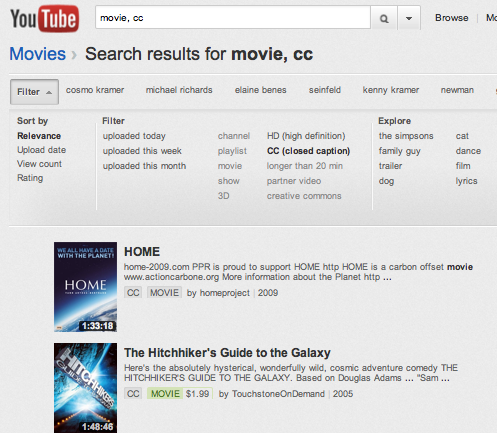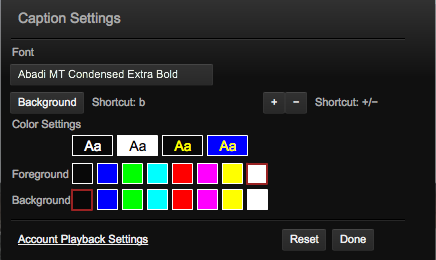Since we first announced caption support in 2006, YouTube creators have uploaded more than 1.6 million videos with captions, growing steadily each year. We’ve also enabled automatic captions for 135 million videos, more than tripling the number of captioned videos available since July 2011. YouTube and Google’s video accessibility team have been hard at work, and we wanted to let you know about some of our progress over the past few months:
For YouTube viewers
More languages: We now support automatic captions and transcript synchronization in Japanese, Korean, and English. Speech recognition for those languages makes it easier for video owners to create captions from a plain transcript. Video owners can also add captions and subtitles in 155 supported languages and dialects, from Afar to Zulu. In Movies and Shows, you can even find out which subtitle languages are available before deciding to rent.

Search for videos with captions: Looking for that great quote from a video on YouTube? Add ", cc" to any search, or after searching, click Filter > CC to only see results with closed captions.

Caption settings: While watching a video, you can change the way the captions look by clicking on the “CC” icon and then the “Settings...” menu item. This includes changing the font size or colors used, and we’re planning to make this available on other platforms and add more options soon.

Broadcast caption support: If the channel owner provides a video caption file in a broadcast format, we now support its position and style information, just like you’d see on TV. This means the text can appear near the character who is speaking, italicized to indicate an off-camera narrator, or even scrolling if the original captions were generated in a real-time mode. Check out this little demo from CPC to see how it looks, or even watch a rental movie with captions like those available from The Walt Disney Studios.
For YouTube creators
More supported formats: YouTube now supports many of the common caption formats used by broadcasters, such as .SCC, .CAP, EBU-STL, and others. If you have closed captions that you created for TV or DVDs, we'll handle the conversion for you.
MPEG-2 caption import: If you upload an MPEG-2 video file that contains closed captions with CEA-608 encoding, we'll import the captions along with the video and create YouTube captions. For example, the nonprofit organization Public.Resource.Org recently added thousands of public domain videos with closed captions to YouTube, coming from government agencies like the National Archives. Here’s some insight from Carl Malamud, President, Public.Resource.Org:
Along with the millions of people like myself who rely on captions and subtitles, we were very encouraged when the Federal Communications Commission published rules governing closed captioning requirements for video on the web, whether that’s to your computer, tablet, phone or other device. We hope these new regulations will drive captions closer to becoming ubiquitous for video everywhere, and in the meantime we’ll keep developing more ways for you to enjoy all the great channels on YouTube.
Ken Harrenstien, software engineer, recently rented “Cars 2” and was ecstatic to see its awesome captions.
For YouTube viewers
More languages: We now support automatic captions and transcript synchronization in Japanese, Korean, and English. Speech recognition for those languages makes it easier for video owners to create captions from a plain transcript. Video owners can also add captions and subtitles in 155 supported languages and dialects, from Afar to Zulu. In Movies and Shows, you can even find out which subtitle languages are available before deciding to rent.
Search for videos with captions: Looking for that great quote from a video on YouTube? Add ", cc" to any search, or after searching, click Filter > CC to only see results with closed captions.
Caption settings: While watching a video, you can change the way the captions look by clicking on the “CC” icon and then the “Settings...” menu item. This includes changing the font size or colors used, and we’re planning to make this available on other platforms and add more options soon.
Broadcast caption support: If the channel owner provides a video caption file in a broadcast format, we now support its position and style information, just like you’d see on TV. This means the text can appear near the character who is speaking, italicized to indicate an off-camera narrator, or even scrolling if the original captions were generated in a real-time mode. Check out this little demo from CPC to see how it looks, or even watch a rental movie with captions like those available from The Walt Disney Studios.
For YouTube creators
More supported formats: YouTube now supports many of the common caption formats used by broadcasters, such as .SCC, .CAP, EBU-STL, and others. If you have closed captions that you created for TV or DVDs, we'll handle the conversion for you.
MPEG-2 caption import: If you upload an MPEG-2 video file that contains closed captions with CEA-608 encoding, we'll import the captions along with the video and create YouTube captions. For example, the nonprofit organization Public.Resource.Org recently added thousands of public domain videos with closed captions to YouTube, coming from government agencies like the National Archives. Here’s some insight from Carl Malamud, President, Public.Resource.Org:
Many of the DVDs and VHS tapes lying around in our vaults and attics--particularly those that were produced by governments and others that care about accessibility of their videos--already have Closed Captions embedded in them. Pulling that information out automatically and making it visible on YouTube means that these videos will continue to be accessible to new generations of viewers.
Along with the millions of people like myself who rely on captions and subtitles, we were very encouraged when the Federal Communications Commission published rules governing closed captioning requirements for video on the web, whether that’s to your computer, tablet, phone or other device. We hope these new regulations will drive captions closer to becoming ubiquitous for video everywhere, and in the meantime we’ll keep developing more ways for you to enjoy all the great channels on YouTube.
Ken Harrenstien, software engineer, recently rented “Cars 2” and was ecstatic to see its awesome captions.






